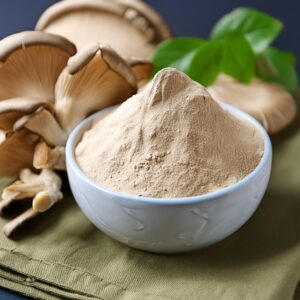What is Chitosan?
Chitosan is pronounced,“Kite’-O-San”. It is a natural biopolymer derived from chitin, the structural component that gives
mushrooms their rigidity and form, crustaceans their outer shell, and insects their exoskeleton.
Origin and Abundance
Chitin is the second most abundant natural polysaccharide in nature, after cellulose.
Most fungi contain 5%-7% chitin in their cell walls.
Chitin is also found in the exoskeletons of crustaceans (crabs, shrimp, lobsters) and insects in levels from 10-40%
Chemical Structure and Properties
Chitosan is obtained through a process called deacetylation of chitin.
Deacetylation: Pronounced “dee-a-SETTLE-ay-shun” (emphasis on “dee”)
This involves:
Removing acetyl groups (CH3OH) from the chitin molecule
Acetyl: Pronounced “A-see-tl” (emphasis on “see”)Creating a polymer with free amine groups (NH2) Amine: Pronounced a-MEEN
This chemical transformation gives chitosan its positive charge, differentiating it from its parent compound, chitin.
Solubility: Unlike chitin, chitosan is soluble in acidic to neutral solutions, making it more versatile for various applications. Our food grade mushroom chitosan oligosaccharide is soluble in water at any pH. It is bactericidal at pH 6.4 and below. To purchase wholesale, click HERE
Biocompatibility and Biodegradability: Chitosan is known for its excellent biocompatibility and biodegradability. It’s non-toxic and can be broken down by natural biological processes.
Uses and Applications:
Chitosan, a versatile biopolymer derived from chitin, has found widespread applications across multiple industries due to its unique properties. This biodegradable and non-toxic compound offers a range of benefits in various sectors:
Healthcare and Pharmaceuticals: Chitosan’s biocompatibility makes it invaluable in medical applications. It is used in wound healing products, drug delivery systems, and as a biomaterial in tissue engineering. Its ability to promote healing and control drug release has made it a popular choice in the pharmaceutical industry.
Environmental Protection: In water treatment, chitosan’s capacity to bind with heavy metals and other contaminants makes it an effective agent for purification processes. This property has led to its use in both industrial and municipal water treatment facilities.
Agriculture: Farmers and agronomists utilize chitosan as a natural biostimulant and elicitor. It enhances plant growth and boosts resistance against pathogens, contributing to more sustainable agricultural practices.
Food Industry: Chitosan serves multiple purposes in food production and preservation. It acts as an antimicrobial food additive and can be used to create edible films or coatings that extend the shelf life of perishable products.
Beverage Production: In the alcoholic beverage industry, chitosan is employed for clarification of wines, beers, and whiskeys, helping to improve their clarity and stability.
Dietary Supplements: The compound is also used in the production of dietary supplements, capitalizing on its potential health benefits.
Plastics Industry: Chitosan’s biodegradable nature makes it an attractive option for developing eco-friendly plastic alternatives.

The wide-ranging applications of chitosan stem from its unique combination of biocompatibility, biodegradability, non-toxicity, and positive charge.
What are the benefits & functions of mushroom chitosan when combined with PLA (Polylactic Acid)?
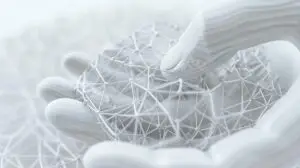
Chitosan, sourced from mushrooms, offers several interesting benefits and functions when incorporated into polylactic acid (PLA) formulas. PLA is a biodegradable polymer derived from renewable sources such as corn starch or sugarcane, commonly used in bioplastics. Here’s how mushroom chitosan can enhance PLA:
Polylactic acid (PLA) is a widely used bioplastic derived from renewable resources like corn starch or sugarcane. While PLA is biodegradable, its degradation rate in natural environments can be slow. Chitosan, a natural polymer derived from crustacean shells, has been found to enhance the biodegradability of PLA when used as a composite material.
Benefits of Chitosan-PLA Composites
Improved Biodegradation: Chitosan can accelerate the degradation process of PLA, making the composite more eco-friendly by improving its biodegradability in natural environments.
Reduced Environmental Impact: By enhancing the biodegradability of PLA, chitosan-PLA composites can help reduce the accumulation of plastic waste in landfills and oceans.
Potential Applications: Chitosan-PLA composites can be used in various applications, such as packaging materials, disposable utensils, and agricultural mulch films, where biodegradability is a desirable feature.
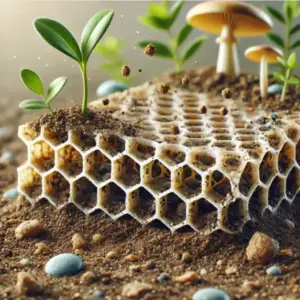
Mechanism of Biodegradation Enhancement
Chitosan, being a natural polymer, is susceptible to enzymatic degradation by microorganisms in the environment. When chitosan is incorporated into PLA, it creates a more porous structure that allows for better penetration of enzymes and microorganisms. This increased surface area and accessibility facilitate the breakdown of the composite material, leading to faster biodegradation compared to pure PLA.
Factors Affecting Biodegradation Rate
The biodegradation rate of chitosan-PLA composites can be influenced by various factors, such as:
Chitosan content: Higher concentrations of chitosan in the composite generally result in faster biodegradation.
Molecular weight of chitosan: Lower molecular weight chitosan tends to degrade more quickly, leading to faster biodegradation of the composite.
Environmental conditions: Temperature, humidity, and the presence of specific microorganisms can affect the rate of biodegradation in natural environments.

Environmental Benefits of Chitosan-PLA Composites
Reduced Carbon Footprint
Chitosan-PLA composites contribute to a lower carbon footprint compared to traditional petroleum-based plastics. This reduction is primarily due to:
Renewable Sourcing: Both materials are obtained from renewable resources. PLA is typically derived from corn starch or sugarcane, while chitosan is extracted from crustacean shells, a byproduct of the seafood industry.
Biodegradability: The enhanced biodegradability of these composites means they break down more quickly in natural environments, releasing less greenhouse gases over time compared to persistent synthetic plastics.
Energy Efficiency: The production of chitosan-PLA composites often requires less energy compared to the manufacturing of conventional plastics, further reducing their overall carbon footprint.
Decreased Reliance on Fossil Fuels
By utilizing renewable resources, chitosan-PLA composites help decrease dependence on fossil fuels:
Resource Conservation: The use of agricultural and marine byproducts as raw materials conserves non-renewable petroleum resources.
Circular Economy: These materials promote a more circular economy by repurposing waste products (like crustacean shells) into valuable materials.
Reduced Extraction Impact: Less reliance on fossil fuels means reduced environmental impacts associated with oil extraction and processing.
Additional Environmental Benefits
Reduced Plastic Pollution: The biodegradability of chitosan-PLA composites helps mitigate the accumulation of plastic waste in ecosystems.
Soil Health: When used in agricultural applications, these composites can break down into non-toxic components that may even benefit soil quality.
Water Conservation: The production of these bio-based materials often requires less water compared to synthetic polymer manufacturing processes.
Challenges and Future Directions
While chitosan-PLA composites offer significant environmental advantages, some challenges remain:
Scale of Production: Increasing production to meet global demand while maintaining sustainability is an ongoing challenge.
Performance Optimization: Continuing research is needed to enhance the mechanical and barrier properties of these composites to match or exceed those of conventional plastics.
End-of-Life Management: Developing efficient composting and recycling systems for these materials is crucial for realizing their full environmental potential.
The combination of chitosan and PLA represents a promising direction in sustainable materials science. As research progresses and production scales up, these composites have the potential to significantly reduce the environmental impact of plastic use across various industries.
- Improved Barrier Properties: Chitosan enhances PLA’s barrier properties against gases like oxygen and oils, essential for packaging applications to maintain the integrity and freshness of packaged goods.
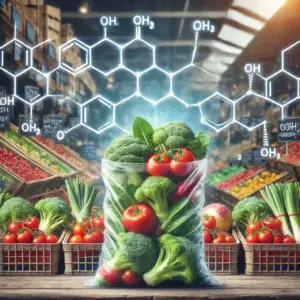
The integration of chitosan into polylactic acid (PLA) can have mixed effects on the mechanical properties, depending on factors like the chitosan content and processing methods. Here are the key points regarding the mechanical strength enhancement of PLA-chitosan composites:
- Tensile Strength: At low chitosan concentrations (around 1-5 wt%), some studies reported an increase in tensile strength. For example, one study found a 14% increase in tensile strength with 1 wt% chitosan addition. However, higher chitosan contents (>5 wt%) generally led to a decrease in tensile strength. This is likely due to poor dispersion and agglomeration of chitosan particles at higher loadings.
- Elastic Modulus: The addition of chitosan typically decreased the elastic modulus (stiffness) of PLA. This is attributed to the lower modulus of chitosan compared to PLA.
- Elongation at Break: Chitosan incorporation generally improved the ductility and elongation at break of PLA. This suggests enhanced flexibility of the composites.
- Optimum Composition: A 50:50 wt% chitosan-PLA blend showed promising results in one study, with a tensile strength of 72 MPa, which was about 3 times higher than native chitosan.
- Processing Effects: The method of incorporating chitosan (e.g., melt blending, solution casting) can significantly impact the final mechanical properties.
- Interfacial Adhesion: Good dispersion and interfacial adhesion between chitosan and PLA are crucial for achieving improved mechanical properties.
- Crystallinity: Chitosan addition can affect the crystallinity of PLA, which in turn influences mechanical properties.

Film-Forming Properties of Chitosan-PLA Composites
Enhanced Film Formation
Improved Processability: Chitosan helps improve the processability of PLA, allowing for easier formation of thin, uniform films.
Flexibility: The addition of chitosan can increase the flexibility of PLA films, making them less brittle and more suitable for various applications.
Surface Properties: Chitosan modifies the surface properties of PLA films, often resulting in improved adhesion and coating characteristics.
Benefits in Agricultural Applications
Mulch Films: Chitosan-PLA composite films can be used as biodegradable mulch films, helping to conserve soil moisture, suppress weeds, and regulate soil temperature.
Controlled Release: These films can be engineered to slowly release fertilizers or pesticides, providing a more sustainable approach to crop management.
Soil Health: As the films degrade, they can contribute positively to soil health, unlike conventional plastic mulches.
Other Applications
Food Packaging: The film-forming ability of chitosan-PLA composites is valuable in creating biodegradable food packaging materials with enhanced barrier properties.
Medical Applications: In the medical field, these films can be used for wound dressings or as carriers for drug delivery systems.
Coatings: The improved film-forming properties make chitosan-PLA composites suitable for various coating applications, including paper and cardboard coatings.
Factors Affecting Film Formation
Chitosan Concentration: The optimal chitosan concentration for film formation varies depending on the specific application and desired properties.
Molecular Weight: The molecular weight of chitosan affects its film-forming ability and the resulting film properties.
Processing Conditions: Factors such as temperature, humidity, and drying methods significantly influence the quality of the formed films.
Plasticizers: The addition of plasticizers can further enhance the film-forming properties and flexibility of chitosan-PLA composites.
Chitosan plays a significant role in improving the thermal stability and processability of polylactic acid (PLA) during manufacturing processes such as extrusion and molding. This enhancement is crucial for expanding the applications of PLA in various industries. Let’s explore how chitosan acts as a processing aid for PLA:
Thermal Stability Enhancement
Increased Decomposition Temperature: Chitosan can increase the thermal decomposition temperature of PLA, allowing for higher processing temperatures without degradation.
Reduced Thermal Degradation: The addition of chitosan helps reduce the thermal degradation of PLA during high-temperature processing, preserving its molecular weight and mechanical properties.
Antioxidant Properties: Chitosan exhibits antioxidant properties that can protect PLA from oxidative degradation during thermal processing.
Improved Processability
Melt Viscosity Modification: Chitosan can modify the melt viscosity of PLA, making it easier to process in extrusion and injection molding operations.
Enhanced Melt Strength: The addition of chitosan can improve the melt strength of PLA, which is beneficial for processes like blow molding and foam extrusion.
Nucleation Effect: Chitosan particles can act as nucleation sites, promoting more uniform crystallization of PLA during cooling, which can lead to improved mechanical properties.
Mechanisms of Action
Intermolecular Interactions: Chitosan forms hydrogen bonds with PLA chains, potentially increasing the overall thermal stability of the composite.
Chain Entanglement: The presence of chitosan can increase chain entanglement in the PLA matrix, which can contribute to improved melt strength and processability.
Barrier Effect: Chitosan may create a barrier effect, slowing down the diffusion of degradation products during thermal processing.
Practical Implications
Wider Processing Window: The improved thermal stability allows for a wider range of processing temperatures, giving manufacturers more flexibility in their operations.
Reduced Energy Consumption: Better processability can lead to reduced energy consumption during manufacturing, as processing can be done at lower temperatures or with shorter cycle times.
Enhanced Product Quality: Improved thermal stability and processability can result in better quality end products with more consistent properties.
New Application Possibilities: The enhanced thermal properties open up possibilities for using PLA-chitosan composites in applications that require higher heat resistance.
Chitosan’s compatibility with polylactic acid (PLA) is indeed a significant advantage in the development of composite materials. This compatibility enhances the overall performance and stability of the blend, both during processing and in the final product. Let’s explore the various aspects of chitosan’s role as a compatibility enhancer for PLA:
Molecular Compatibility
Chemical Structure: Chitosan’s chemical structure, consisting of glucosamine and N-acetylglucosamine units, is compatible with PLA’s ester linkages. This compatibility allows for favorable interactions between the two polymers.
Hydrogen Bonding: Chitosan’s hydroxyl and amino groups can form hydrogen bonds with PLA’s carbonyl groups, promoting better interfacial adhesion between the two components.
Miscibility: At certain concentrations, chitosan can form a miscible blend with PLA, leading to a more homogeneous composite material.
Processing Benefits
- Improved Dispersion: Chitosan helps in achieving better dispersion of additives within the PLA matrix, resulting in more uniform properties throughout the composite.
- Reduced Phase Separation: The compatibility between chitosan and PLA minimizes the risk of phase separation during processing, which could otherwise lead to inconsistent material properties.
- Enhanced Processability: The presence of chitosan can improve the melt behavior of PLA, making it easier to process without compromising the integrity of the blend.
Stability During Usage
- Mechanical Integrity: The good compatibility between chitosan and PLA helps maintain the mechanical properties of the composite over time, reducing the risk of delamination or other forms of structural failure.
- Thermal Stability: Chitosan’s compatibility with PLA can contribute to improved thermal stability of the composite, helping to maintain its integrity under varying temperature conditions.
- Moisture Resistance: The interaction between chitosan and PLA can potentially improve the moisture resistance of the composite, helping to maintain its properties in humid environments.
Functional Properties
- Biodegradability: The compatibility of chitosan with PLA ensures that the biodegradability of the composite is maintained or even enhanced, without compromising the material’s integrity during its intended lifespan.
- Barrier Properties: The good compatibility can lead to improved barrier properties against gases and moisture, which is particularly beneficial in packaging applications.
- Antimicrobial Activity: Chitosan’s inherent antimicrobial properties can be effectively incorporated into the PLA matrix due to their compatibility, enhancing the overall functionality of the composite.
Challenges and Considerations
- Optimal Concentration: Determining the optimal concentration of chitosan is crucial, as excessive amounts can lead to agglomeration and potentially compromise the composite’s properties.
- Processing Conditions: Careful control of processing conditions is necessary to fully leverage the compatibility between chitosan and PLA and achieve the desired properties in the final product.
- Long-term Stability: While chitosan enhances compatibility, long-term studies are needed to ensure the sustained integrity of the composite under various environmental conditions.
Incorporating mushroom chitosan into PLA opens up new avenues for developing biodegradable, antimicrobial, and mechanically robust materials suitable for a variety of industrial applications, especially bioplastics and films.
What are the forms of chitosan used in PLA material?
Chitosan derived from sources like mushrooms and shellfish can be processed into various forms suitable for blending with PLA (Polylactic Acid). Here are the typical forms and their suitable applications, along with the addition of mushroom chitosan to PLA (Polylactic Acid), which can vary significantly depending on the desired properties and the specific application:
Forms of Chitosan
Chitosan’s availability in powder form and its compatibility with PLA make it an excellent additive for creating biodegradable composites. Let’s explore the key aspects of using chitosan powder in PLA composites:
Powder Form Characteristics
Chitosan powder is the most versatile and commonly used form for blending with PLA. Its fine particle size offers several advantages:
- Easy Blending: The powder can be easily mixed with PLA granules before extrusion, ensuring uniform dispersion.
- Versatility: It’s suitable for various processing methods, including extrusion and film production.
- Consistent Results: The fine powder allows for more consistent and predictable outcomes in the final composite.
Addition Ratios and Effects
The amount of chitosan added to PLA typically ranges from 1% to 10% by weight. The effects of different ratios are as follows:- 1-2% Addition:
- Mechanical Properties: Minimal to moderate improvement
- Biodegradability: Slight to moderate enhancement
- 5% Addition:
- Mechanical Properties: Significant improvement
- Biodegradability: Enhanced
- 10% Addition:
- Mechanical Properties: Potential diminishing returns on strength
- Biodegradability: May lead to degradation issues
Suitable Applications
Chitosan-PLA composites in powder form are versatile and can be used in various applications:- Disposable Cutlery:
- Properties: Lightweight and biodegradable
- Benefits: Reduces plastic waste
- Plates:
- Properties: Durable yet compostable
- Benefits: Suitable for single-use items
- Packaging Films:
- Properties: Good barrier properties
- Benefits: Sustainable alternative to plastic
- Agricultural Mulch Films:
- Properties: Moisture retention and biodegradable
- Benefits: Supports sustainable agriculture

Characteristics of Chitosan Nanoparticles
- Size Range: ChNPs typically range from 70-1000 nm, with most applications using particles in the 84-600 nm range.
- Preparation Methods:
- Ionic gelation is the most common method for producing ChNPs.
- Other methods include emulsion cross-linking, coacervation, and reverse micelle techniques.
- Surface Properties: ChNPs have a high surface area, which allows them to be effective at lower concentrations.
Addition to PLA Composites
- Adding Ratio: ChNPs are typically added in small quantities, ranging from 0.5% to 5% by weight.
- Dispersion: Good dispersion of ChNPs in the PLA matrix is crucial for optimal property enhancement. Agglomeration can occur at higher concentrations (e.g., 5 wt%).
- Processing: ChNPs can be blended with PLA granules before extrusion, allowing for uniform dispersion within the polymer matrix.
Effects on PLA Properties
- Mechanical Properties:
- ChNPs can improve the mechanical strength of PLA composites at low concentrations.
- However, some studies report a decrease in stiffness and extensibility with the addition of chitosan particles.
- Barrier Properties: ChNPs can enhance the barrier properties of PLA, which is particularly beneficial for packaging applications.
- Thermal Behavior: At low concentrations, ChNPs do not significantly affect the thermal behavior of PLA.
- Antimicrobial Activity: ChNPs can provide antimicrobial properties to the PLA composite, though some studies report a decrease in antimicrobial activity with chitosan addition.
Suitable Applications
- High-Performance Packaging: ChNP-PLA composites are suitable for high-quality food packaging films requiring superior barrier properties and microbial resistance.
- Medical Devices: The composites can be used in precision medical devices, benefiting from enhanced mechanical properties and potential antimicrobial effects.
- Drug Delivery Systems: ChNPs in PLA can be used for the controlled release of drugs or bioactive compounds.
- Coatings: The composites are suitable for coatings requiring high strength and microbial resistance.

Chitosan Fibers in PLA Composites
Chitosan fibers can be effectively incorporated into polylactic acid (PLA) to create composite materials with enhanced structural integrity and mechanical properties. This combination leverages the biodegradability of both materials while improving overall performance.Characteristics of Chitosan Fiber-Reinforced PLA
- Enhanced Mechanical Properties:
- Chitosan fibers can significantly improve the tensile strength and flexibility of PLA composites.
- The degree of enhancement depends on the fiber content and dispersion quality.
- Biodegradability:
- Both chitosan and PLA are biodegradable, making the composite environmentally friendly.
- The degradation rate can be tailored by adjusting the chitosan fiber content.
- Structural Integrity:
- Chitosan fibers provide additional structural support to the PLA matrix, improving overall durability.
Adding Ratio and Effects
The chitosan fiber content in PLA composites typically ranges from 5% to 30% by weight. The effects of different ratios are as follows:- 5-10% Chitosan Fiber:
- Moderate improvement in tensile strength
- Slight increase in flexibility
- Minimal impact on biodegradation rate
- 15-20% Chitosan Fiber:
- Significant improvement in tensile strength
- Noticeable increase in flexibility
- Potential for optimized balance between strength and biodegradability
- 25-30% Chitosan Fiber:
- Maximum enhancement of mechanical properties
- Substantial increase in flexibility
- May affect processability and potentially slow down biodegradation
Suitable Applications
Chitosan fiber-reinforced PLA composites are particularly well-suited for:- Biodegradable Plant Pots:
- Enhanced durability for handling and transportation
- Controlled biodegradation rate in soil
- Structural Panels in Green Construction:
- Improved mechanical strength for load-bearing applications
- Eco-friendly alternative to traditional materials
- Eco-Friendly Textiles:
- Enhanced tensile strength for durable fabrics
- Biodegradable option for sustainable fashion
- Agricultural Mulch Films:
- Improved tear resistance
- Controlled biodegradation for soil health
- Packaging Materials:
- Enhanced structural integrity for protective packaging
- Biodegradable alternative to conventional plastics
Processing Considerations
- Fiber Dispersion: Ensuring uniform dispersion of chitosan fibers in the PLA matrix is crucial for optimal property enhancement.
- Processing Methods: Techniques like extrusion and injection molding can be used, but processing parameters may need adjustment to accommodate the fiber content.
- Moisture Sensitivity: Care must be taken to control moisture during processing, as both chitosan and PLA are sensitive to hydrolysis.
- Enhanced Mechanical Properties:
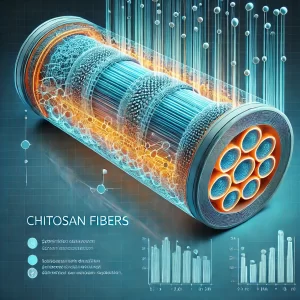
Chitosan Solutions and Gels in PLA Composites
Chitosan can be dissolved in specific solvents to create solutions or gels that can be effectively mixed with PLA during polymer processing. This method is particularly useful for film casting and fiber spinning processes.Dissolution Methods
- Acetic Acid Solution (1-3%):
- Most common and effective method
- Forms a homogeneous solution or gel
- Widely used in various applications
- Acidified Water:
- Limited solubility
- Requires low pH (acidic conditions)
- Ethanol (50-70%):
- Can dissolve chitosan by creating a solubilizing solution
- Less common than the acetic acid method
Adding Ratio and Concentrations
- Chitosan Solution Concentration:
- Typically ranges from 1% to 3%
- Varies slightly based on the specific application:
- Agricultural Films: 1-3%
- Medical Textiles: 1-3%
- Food Packaging: 1-2%
- PLA Mixing Ratios:
- Agricultural Films: 70-90% PLA
- Medical Textiles (e.g., Wound Dressings): 60-80% PLA
- Food Packaging: 65-85% PLA
Suitable Applications
- Film Casting:
- Biodegradable films benefiting from chitosan’s microbial resistance
- Agricultural mulch films:
- Promotes sustainability
- Enhances soil health
- Food packaging films:
- Antimicrobial properties
- Biodegradable alternative to conventional plastics
- Fiber Spinning:
- Creation of fibers with antimicrobial properties
- Medical textiles:
- Wound dressings with enhanced antimicrobial protection
- Biocompatible materials for medical applications
- Protective textiles:
- Clothing or materials requiring antimicrobial properties
- Medical Applications:
- Wound dressings:
- Combines PLA’s structural properties with chitosan’s antimicrobial effects
- Biocompatible and biodegradable
- Wound dressings:
Processing Considerations
- Uniform Dispersion: Ensuring even distribution of the chitosan solution within the PLA matrix is crucial for consistent properties.
- Solvent Removal: Care must be taken to properly remove any residual solvents during processing to maintain the integrity and safety of the final product.
- Viscosity Control: The addition of chitosan solution can affect the viscosity of the PLA blend, which may require adjustments in processing parameters.
- pH Management: Given that chitosan is often dissolved in acidic solutions, pH control during processing and in the final product is important, especially for biomedical applications.
- Acetic Acid Solution (1-3%):

- Surgical Sutures:
- Chitosan-PLA composites can be used to create biodegradable sutures that dissolve over time.
- The antimicrobial properties of chitosan help prevent post-surgical infections.
- Implants:
- These composites are suitable for various implantable devices due to their biocompatibility and biodegradability.
- Examples include bone screws, plates, and tissue engineering scaffolds.
- Drug Delivery Systems:
- Chitosan-PLA composites can be formulated into nanoparticles or microspheres for controlled drug release.
- The cationic nature of chitosan allows for better drug encapsulation and targeted delivery.
Advantages in Medical Applications
- Enhanced Mechanical Properties: Adding chitosan to PLA can improve the mechanical strength and flexibility of the composite, making it suitable for load-bearing applications.
- Improved Cell Adhesion: Chitosan promotes cell adhesion and proliferation, which is beneficial for tissue engineering applications.
- Controlled Degradation: By adjusting the ratio of chitosan to PLA, the degradation rate of the composite can be tailored to match the healing process.
- Reduced Inflammatory Response: Chitosan has been shown to reduce inflammatory responses, which is crucial for implantable devices.
- Surgical Sutures:
 Advantages of Chitosan-PLA Composites in Food PackagingAntimicrobial Properties
Advantages of Chitosan-PLA Composites in Food PackagingAntimicrobial PropertiesEnhanced Barrier Properties
- Oxygen Barrier: Chitosan improves the oxygen barrier properties of PLA, helping to prevent oxidation of food products.
- Moisture Barrier: The addition of chitosan can enhance the moisture barrier properties of PLA, crucial for maintaining food quality and texture.
- Reduced Permeability: Chitosan-PLA composites show reduced permeability to gases and vapors compared to pure PLA.
Biodegradability and Sustainability
- Eco-Friendly Alternative: Both chitosan and PLA are biodegradable, offering a sustainable alternative to conventional plastic packaging.
- Reduced Environmental Impact: The use of these composites can help reduce plastic waste associated with food packaging.
Applications in Food Packaging
- Fresh Produce Packaging:
- Extends the shelf life of fruits and vegetables
- Maintains freshness by controlling moisture and gas exchange
- Meat and Poultry Packaging:
- Inhibits bacterial growth, particularly important for raw meats
- Helps maintain color and prevent spoilage
- Dairy Product Packaging:
- Protects against mold and yeast growth
- Maintains product quality and extends shelf life
- Baked Goods Packaging:
- Prevents mold growth
- Maintains texture by controlling moisture
- Active Packaging Systems:
- Incorporation of antioxidants or other active compounds into the packaging material
- Gradual release of active components to enhance food preservation
Factors Affecting Performance
- Chitosan Concentration:
- Typically ranges from 1% to 5% in the composite
- Higher concentrations generally provide stronger antimicrobial effects but may impact mechanical properties
- Molecular Weight of Chitosan:
- Affects the strength of antimicrobial activity and barrier properties
- Lower molecular weight chitosan often shows higher antimicrobial activity
- Processing Methods:
- Extrusion, film casting, and coating techniques can be used
- Processing conditions affect the final properties of the packaging material
- Environmental Conditions:
- Temperature and humidity during storage can impact the performance of the packaging
Challenges and Future Directions
- Cost Considerations:
- Chitosan-PLA composites may be more expensive than conventional plastics
- Economies of scale and improved processing methods may reduce costs over time
- Regulatory Approval:
- Ensuring compliance with food safety regulations in different regions
- Optimization of Properties:
- Balancing antimicrobial efficacy with mechanical and barrier properties
- Tailoring composites for specific food types and storage conditions
- Consumer Acceptance:
- Educating consumers about the benefits and safety of these new packaging materials
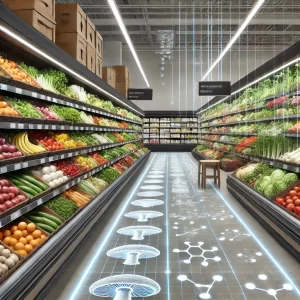
Benefits of Chitosan-PLA Agricultural Films
- Control of Soil Temperature:
- Chitosan-PLA mulch films help regulate soil temperature by providing insulation.
- This temperature regulation promotes seed germination and plant growth.
- Stable soil temperatures can extend growing seasons and protect crops from extreme weather conditions.
- Weed Growth Prevention:
- These films effectively suppress weed growth, reducing the need for chemical herbicides.
- By preventing weed proliferation, chitosan-PLA mulches promote a healthier ecosystem and reduce competition for nutrients and water.
- Soil Moisture Retention:
- Chitosan-PLA films help maintain soil moisture by limiting evaporation.
- This moisture retention is critical for crop development, especially in arid regions.
- Improved water efficiency can lead to reduced irrigation needs and better crop yields.
Environmental Impact and Sustainability
- Biodegradability:
- Unlike traditional plastic films, chitosan-PLA mulches biodegrade naturally, reducing plastic pollution in agricultural lands and water bodies.
- This biodegradability eliminates the need for film removal and disposal, saving labor and reducing waste.
- Soil Health Preservation:
- Chitosan-PLA films enhance soil health by preventing chemical leaching associated with conventional plastics.
- The natural degradation of these films maintains the soil’s microflora and overall quality.
- Improved Waste Management:
- Being compostable, chitosan-PLA films contribute to better agricultural waste management practices.
- They provide an eco-friendly solution to the problem of plastic waste accumulation in agricultural settings.
Performance and Practical Applications
- Effectiveness in Various Crop Settings:
- Studies have shown that chitosan-PLA mulch films are effective in controlling weeds and retaining moisture across different crop types.
- Degradation Rates and Crop Yield Impact:
- Research focuses on the performance characteristics of these films, including their degradation rates in real agricultural conditions.
- Studies compare the impact on crop yield between chitosan-PLA films and conventional plastics, providing valuable insights for farmers.
Challenges and Future Directions
- Optimization of Film Properties:
- Ongoing research aims to fine-tune the composition and manufacturing processes to enhance durability and effectiveness while maintaining biodegradability.
- Cost Considerations:
- As with many sustainable alternatives, the initial cost of chitosan-PLA films may be higher than traditional plastic mulches. However, long-term environmental benefits and potential increases in crop yield may offset these costs.
- Adaptation to Different Climates:
- Further studies are needed to assess the performance of these films in various climatic conditions and for different crop types.
- Control of Soil Temperature:
Properties of Chitosan-PLA Blended Textiles
- Biodegradability:
- Both chitosan and PLA are biodegradable, making the resulting textiles environmentally friendly.
- The rate of biodegradation can be tailored by adjusting the ratio of chitosan to PLA.
- Antimicrobial Properties:
- Chitosan provides natural antimicrobial properties to the textile.
- This is particularly beneficial for medical textiles and sportswear.
- Moisture Management:
- Chitosan has excellent moisture-wicking properties.
- PLA contributes to moisture resistance, creating a balanced moisture management system.
- Biocompatibility:
- Both materials are biocompatible, making them safe for use in medical applications and direct skin contact.
- Mechanical Properties:
- The blend can be engineered to achieve desired strength, flexibility, and durability.
- PLA provides structural integrity while chitosan enhances flexibility.
Applications in Medical Textiles
 Bandages and Gauze:
Bandages and Gauze:
- Antimicrobial properties help prevent infections.
- Biodegradability reduces medical waste.
- Moisture management properties promote wound healing. Surgical Dressings:
- Biocompatibility ensures safe use in surgical settings.
- Controlled biodegradation can eliminate the need for dressing removal. 1. Implantable Textiles:
- Used in tissue engineering scaffolds.
- Gradual biodegradation supports tissue regeneration.
- Protective Medical Wear:
- Antimicrobial properties provide an additional layer of protection for healthcare workers.
Applications in Eco-Friendly Clothing
- Sportswear:
- Moisture-wicking properties enhance comfort during physical activities.
- Antimicrobial features reduce odor-causing bacteria.
- Undergarments:
- Soft texture and antimicrobial properties make them ideal for intimate wear.
- Biodegradability addresses the environmental impact of fast fashion.
- Outdoor Clothing:
- Durability combined with eco-friendliness appeals to environmentally conscious consumers.
- Natural antimicrobial properties are beneficial for extended outdoor use.
- Fashion Accessories:
- Biodegradable bags, scarves, and other accessories offer sustainable alternatives.
Manufacturing Process
- Fiber Blending:
- Chitosan and PLA are typically blended at the fiber level.
- The ratio can be adjusted to achieve desired properties.
- Spinning Techniques:
- Wet spinning or electrospinning are common methods for producing chitosan-PLA fibers.
- These techniques allow for control over fiber diameter and properties.
- Textile Formation:
- Woven, knitted, or nonwoven fabrics can be produced depending on the application.
Challenges and Future Directions
- Cost Optimization:
- Reducing production costs to make chitosan-PLA textiles more competitive with conventional fabrics.
- Performance Enhancement:
- Improving durability and longevity while maintaining biodegradability.
- Enhancing color fastness and dyeability.
- Scalability:
- Developing efficient large-scale production methods for widespread adoption.
- Regulatory Compliance:
- Ensuring compliance with textile and medical regulations across different markets.
- Consumer Education:
- Raising awareness about the benefits and proper care of biodegradable textiles.
- Sportswear:
- Antimicrobial properties provide an additional layer of protection for healthcare workers.
- Biodegradability:

- Enhanced Properties:
- The addition of chitosan to PLA filaments can improve certain properties of the printed objects, particularly antimicrobial activity and biodegradability.
- Chitosan can enhance the barrier properties and moisture resistance of PLA prints.
- Printability:
- Low concentrations of chitosan (around 1-3%) can be incorporated into PLA filaments while maintaining printability.
- Higher concentrations (e.g. 10%) tend to make printing difficult or impossible.
- Mechanical Properties:
- The addition of chitosan generally decreases the stiffness and extensibility of PLA.
- However, some studies found that low concentrations (1-3%) of chitosan could improve certain mechanical properties like compression strength.
- Processing:
- Chitosan powder can be blended with PLA pellets and then extruded to create 3D printing filaments.
- The extrusion process needs to be optimized to ensure good dispersion of chitosan particles.
- Applications:
- Due to improved biocompatibility and antimicrobial properties, chitosan-PLA filaments show potential for biomedical applications like customized medical devices.
- They can be used to create biodegradable components with tailored degradation rates.
- Challenges:
- Achieving uniform dispersion of chitosan in PLA is crucial for consistent properties.
- Chitosan content that is too high tends to negatively impact printability and mechanical properties.
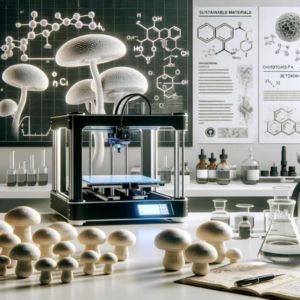
These forms and applications demonstrate the flexibility and utility of chitosan when used in conjunction with PLA, making it a valuable material for a wide range of sustainable and high-performance applications.
Which type of chitosan is suitable for each form of PLA?
The suitability of different types of chitosan for specific forms and applications in PLA (Polylactic Acid) depends on their chemical characteristics, such as viscosity, solubility, and molecular modification. Here’s a guide to which type of chitosan is most appropriate for each form of PLA, considering the viscosity range and specific chitosan derivatives:
1. Low-Cost, High Molecular Weight Chitosan
(Viscosity Range)
- 20-100cps: This lower viscosity chitosan is ideal for film applications where a smoother, more uniform dispersion is needed. It can be used in solutions or gels to produce thin, flexible films for packaging or agricultural films.
- 100-500cps: This medium viscosity is suitable for applications needing a balance between ease of processing and mechanical strength. It’s effective in general-purpose blending for items like disposable cutlery, where moderate improvements in mechanical properties are beneficial.
- 500-1000cps: Higher viscosity chitosan provides more substantial interactions within the PLA matrix, making it suitable for composites intended for structural applications where increased strength and stiffness are desired.
2. Chitosan Hydrochloride
- Suitable Form: Powder and nanoparticles. Chitosan hydrochloride is highly soluble in water, making it suitable for creating nanoparticle suspensions or fine powders that can easily be blended with PLA.
- Applications: Due to its excellent solubility and antimicrobial properties, it is ideal for medical devices and active packaging solutions that require high levels of microbial resistance.
3. Chitosan Oligosaccharide
- Suitable Form: Solution or gel. Chitosan oligosaccharides, being low molecular weight, dissolve well and are ideal for coating applications or incorporation into PLA as a solution.
- Applications: Particularly useful in coatings and films where antimicrobial properties are needed without significantly altering the mechanical properties of PLA. Suitable for food packaging and medical films.
4. Carboxymethyl Chitosan
- Suitable Form: Powder, solution, or fibers. Carboxymethyl chitosan is water-soluble and can modify the hydrophilicity of PLA composites.
- Applications: This derivative is excellent for applications requiring enhanced water resistance and stability, such as water-resistant textiles, wound care products, and environmentally sensitive applications where moisture management is critical.
General Guidelines for Application:
- Films and Coatings: Use lower viscosity acid-soluble chitosan or chitosan oligosaccharide for better film-forming capabilities and uniformity.
- Structural Components: Opt for higher viscosity acid-soluble chitosan to improve mechanical properties.
- Medical and Food Packaging: Chitosan hydrochloride and oligosaccharides are preferable for their soluble properties and antimicrobial effects, enhancing the safety and the shelf life of products.
Choosing the right type of chitosan based on these properties ensures the enhanced performance of PLA in various applications, maximizing the benefits of this biodegradable composite.
Discussion – Chitosan plus PLA (Polylactic Acid)
Chitosan is a compelling biopolymer for enhancing the properties of polylactic acid (PLA) materials, commonly used in biodegradable plastic applications.
When integrated into PLA, chitosan not only improves the environmental profile of the composite by enhancing its biodegradability but also adds functional advantages like antimicrobial activity which is crucial for applications ranging from food packaging to medical implants.

The integration of chitosan from mushrooms into polylactic acid (PLA) materials represents a significant advancement in sustainable and high-performance bioplastics. This combination offers a versatile and eco-friendly alternative to conventional petroleum-based plastics, with applications spanning various industries.
Book a Free Consultation
If you don’t know what type of chitosan is best for your situation, Book an appointment. we will offer you an initial 30-minute consultation and product quotation at no charge.

